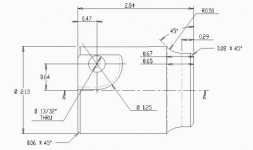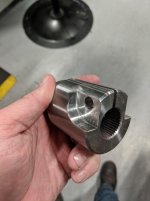MrEastwood31
Plastic
- Joined
- Feb 14, 2018
I am having a difficult time finding an easy solution to measuring this 13/32" bolt hole location. I have to measure the center of the thru hole off the face of the part (.47) and then measure the center of the hole to the center of the part diameter (.64), or at least off the OD of the part. I have scrubbed Mitutoyo and they have a centerline caliper but it is 18" long. Is there a company that has a caliper or micrometer that would allow us to quickly measure this dimension. See attached pic. 






